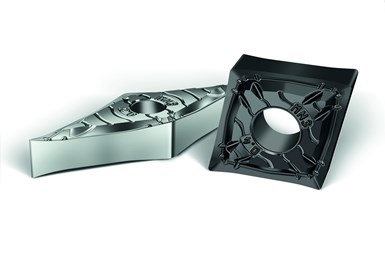Walter's New Inserts Machine Non-Ferrous Materials
The polished rake face of the new inserts is said to improve chip removal, and the extremely sharp cutting edge creates a softer cutting action. The softer cutting action enables machining of unstable components and components with long overhangs.
Share




Walter has introduced the MN3 insert geometry specially designed for cost-effective machining of non-ferrous (ISO N) materials. According to Walter, the geometry is ideal for the medium machining of non-ferrous metals (including aluminum, copper or brass alloys) and secondarily for the fine finishing of small components made from steel, stainless-steel and high-temperature alloys.
Positive with four cutting edges, the inserts can be used on both sides. The polished rake face is said to improve chip removal, and the extremely sharp cutting edge creates a softer cutting action. The softer cutting action reportedly enables successful machining of unstable components and components with long overhangs.
Walter is launching the new indexable insert in two grades: WN10 a cost-effective, uncoated, polished grade, and WNN10 with a wear resistant high-power impulse magnetron sputtering (HIPIMS) physical vapor deposition (PVD) coating, with an extremely smooth surface and an optimized layer bonding.
MN3 is said to be the first Walter geometry to have double the number of cutting edges while also being highly positive, with a 29° rake angle on the radius. Walters says this enables users to benefit from improved chip breaking — even when working with lead-free materials like CuZn21Si3P. The surface roughness was also optimized, which reportedly enables an increased tool life even when working with materials that tend to stick with built-up edges. The negative basic shape with double the number of cutting edges is designed to increase productivity and cost-efficiency.



















.jpg;maxWidth=300;quality=90)



